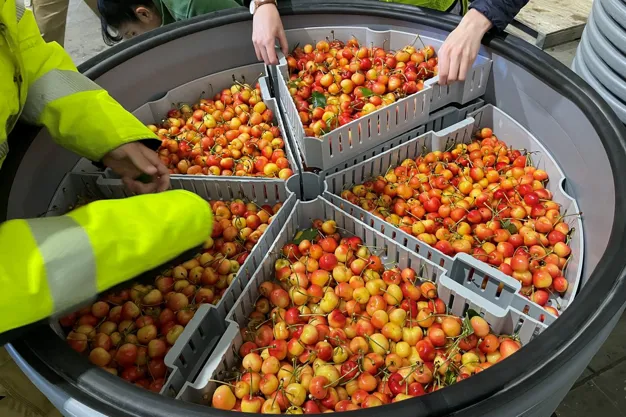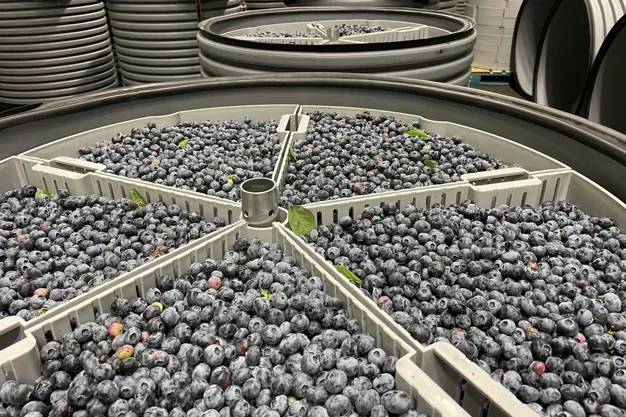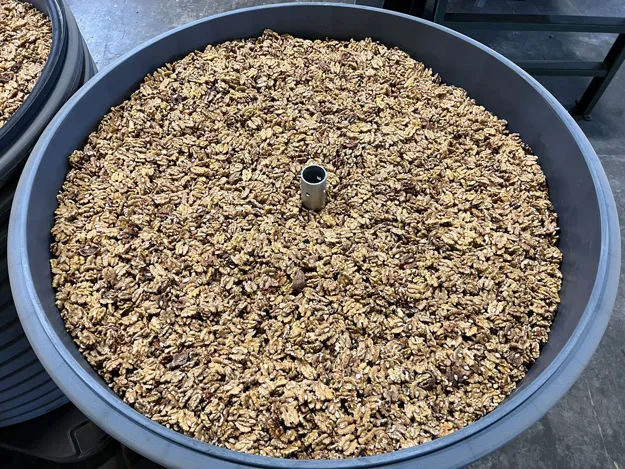Whether it’s an apple, a cherry, a blueberry, or any other fruit, as soon as it has been harvested, the product is no longer getting water and nutrients and the process of senescence starts. During this process, the fruit consumes O2, and produces CO2. Not only does the quality deteriorate, the amount of nutrients diminishes, and the fruit becomes less flavorful.
In recent years, many technologies have been developed to extend the shelf-life of produce. One of them is RipeLocker and according to the company’s Founder and CEO, George Lobisser, this technology is different and more disruptive compared to anything else out there. “Our technology is focused on extending the shelf-life by suppressing decay while keeping the flavor and nutrients,” Lobisser said.

Timing the perfect sales moment
In a RipeLocker, the perishable is held in a vacuum under ultra-low pressure, which means it gets very little oxygen. The amount of air is about four percent of what a human breathes. It is low enough to put the perishable to sleep, but high enough to prevent the product from going anaerobic. “If the amount of oxygen is too low, the perishable is being choked and the process of fermentation starts, so it is important to keep it at the optimum low level,” Lobisser said. The air inside the vacuum is being monitored 24/7 by controlling the O2 vs. CO2 ratio, which is supposed to be about 1:1. This means that for every one millibar of oxygen being consumed, the perishable is off-gassing one millibar of CO2.” If that ratio changes and more CO2 is being generated, the fruit is being choked and requires more oxygen. If the perishable receives more oxygen and it’s still not possible to bring the ratio to 1:1, that means the fruit is going bad. “When that happens, we advise the grower-packer to sell their fruit. The key is to know when the fruit is going bad and with a RipeLocker, this can be monitored 24/7 and the results can be read instantly on a cell phone.”
No weight loss
Another benefit of a RipeLocker is that the vacuum vaporizes water, and the water turns into a gas. If a RipeLocker is filled with blueberries, the berries give off water, which turns into a vapor, fully saturating the air. “If that happens, the fruit can’t dehydrate because the water molecules can’t go anywhere. As a result, over a time frame of 60 days, we’ve seen blueberries gain weight instead of losing it.,” Lobisser shared.

Insect-free
The company is currently doing some work with a major walnut grower-shipper, focused on killing insects, their eggs, as well as larvae. “The opportunity came our way through the U.S. Department of Agriculture as they are looking for ways to end the use of methyl bromide, a gas used to control pests and insects. “We knew insects couldn’t survive in a RipeLocker, but if the eggs and larvae hatch, it would cause a big problem. We’ve done some trials and are excited to share that we are able to kill insects, eggs, and larvae in a RipeLocker without the use of chemicals.”
During the trial time, the shelf-life of walnuts was also tested. “First, we held them for 12 months and then we kept the walnuts in a RipeLocker for two years. Since walnut trees are alternate bearing, it can be beneficial for a grower to hold on to the product longer during a small harvest and get a higher price for their product. “We did a test with a two-year-old walnut in one hand and a fresh one in the other hand and the results were very positive. The panel liked the two-year-old walnut best,” Lobisser shared.

Walnuts in RipeLocker.
Pallet size
RipeLockers were designed to move through the logistics chain. Therefore, they are the size of a pallet. “Perishables stay in fabulous shape while they are in a RipeLocker because the senescence and decay are being delayed.” However, the process of senescence starts as soon as the perishable comes out of the RipeLocker. “Therefore, we want the fruit to get out of the RipeLocker as close to their final destination, the store, as possible.”
It all comes down to harvesting the fruit at optimal ripeness because that’s when it’s most flavorful and most nutritious. By delaying senescence, we are at the same time delaying the breakdown of the nutrients. All without the use of any chemicals. “It’s simple fruit physiology,” said Lobisser. “Our system has been developed for growers-packers who would like to differentiate by selling fruit that is tastier and more nutritious as these are the two reasons people buy fruit. We are working with grower-packers who would like to change their game.”
Global reach
RipeLocker is currently working with clients in South Africa, Europe, South America, and North America. Outside of fresh fruit, we see a lot of opportunities with flowers. Another area of opportunity is retailers having a strong preference for perishables that are being shipped by boat instead of air. “Shipping by air creates about 44 times more CO2, but because the journey is longer, it won’t arrive in the same condition as an air-freighted product. However, if retailers decide to make the shift and highly perishable items will sit on a boat for a few weeks, we are the only game in town to guarantee flavorful and nutritious arrivals.”
“Our technology is not for everyone. It is for growers, packers, shippers, and retailers who want to differentiate themselves by offering better tasting, longer shelf-life, and more nutritious fruit resulting in better pricing and/or increased market share,” Lobisser concluded.
 For more information:
For more information:
George Lobisser
RipeLocker
Email: george@ripelocker.com
www.ripelocker.com
